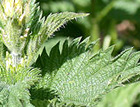Food for free: foraging
Nettles are good for lasagne, and wild garlic in potato salad. Elisabeth Luard identifies some of the wonderful plants you can forage for this spring


Wild garlic Good for... potato salad Wild garlic, Allium ursinum, is a slender-rooted cousin of our clove-producing, cultivated kind. It grows in thick drifts in damp verges and woodlands throughout southern England and Wales. Gather them now when the leaves are still young and tender, before the flower-spikes shoot up. If in doubt of the plant's identity, crush any part between your fingers-there's no mistaking the scent. To gather, pull gently in a small clump, cropping only a handful from each patch and causing as little disturbance as possible. The leaves are delicious in potato salad. To cook, shred or chop finely and stir into boiling cream as a sauce for poached fish, chicken or vegetables, include in an omelette or quiche, or stir into a stew at the end, as you would parsley, to add colour and flavour.
Mint Good for... jelly To the tidy gardener, it's a pest: once established, you'll never get rid of it-although why on earth, the cook might ask, would anyone want to? Although the common or cottage-garden mint, Mentha spicata, is the variety most commonly used for mint sauce, those who know their lamb and like it with mint jelly prefer the apple mint, which has rounder leaves and a delicate, appley flavour. Pennyroyal is valued for its fragrance and its disinfectant properties. Peppermint is best for drying, and was widely cultivated for its oil, and watermint is the variety you'll find everywhere in the wild.
Dandelion Good for... scrambled eggs Look out for the young rosettes formed of a perfect circle of heavily indented leaves centred by a tight little bud, cover with an upturned flowerpot and wait for a week or two. You'll find the leaves lose much of their bitterness. They can be eaten raw in salads, or cooked in the same way as spinach: wilt in a little water with salt, drain thoroughly, toss over the heat with plenty of butter and finish with a squeeze of lemon to balance the bitterness. You can also include the shredded leaves in an omelette or scrambled eggs.
Watercress Good for... soup Watercress spreads its carpet of dark-green, heart-shaped leaves in streams and waterways throughout the land. When picking from the wild, be sure of a clean source-beneath a waterfall or fast-moving stream-as the tangle of greenery can harbour unwanted visitors, particularly when sheep are about. In spring, the leaves are still small, the stalks are tender and the plant can be eaten in its entirety. Raw, its distinctively peppery taste is refreshing and mineraly. Cooked, the flavour softens, and works well in creamy sauces and soups. Rich in iron and vitamins A and C, medieval herbalists considered it fortifying and digestive.
Nettles Good for... lasagne When gathering nettles for the pot, choose a nice clean patch and wear gloves. As long as the nettles haven't yet flowered, all the upper leaves, once stripped from their fibrous stalks, will be tender enough to cook. The flavour and texture is much like that of chewy, iron-rich spinach. For a classic nettle soup, cook them with diced potato in milk or chicken stock (or both) and, when all is soft, whizz up until smooth. Or stir into a white sauce and layer into a lasagne, use to sauce macaroni or as a stuffing for rolled-up pancakes baked as a gratin.
Horseradish Good for... sauce Horseradish is a particularly fiery member of the mustard family. As a partner to rich meats, it's a wake-up call to the digestion. The active ingredient, a volatile oil that acts as a defence against predators (including humans), is released only when the root is cut or bruised, but disappears when heat is applied-which, no doubt, is why it tastes so good stirred into cold cream as an accompaniment to the roast beef of Old England. To prepare fresh horse-radish roots, scrub, scrape, remove the woody inner core and grate the outer layer. To store (once grated, horseradish quickly loses its pungency), leave the root whole, scrub well, and freeze.
Exquisite houses, the beauty of Nature, and how to get the most from your life, straight to your inbox.
Country Life is unlike any other magazine: the only glossy weekly on the newsstand and the only magazine that has been guest-edited by His Majesty The King not once, but twice. It is a celebration of modern rural life and all its diverse joys and pleasures — that was first published in Queen Victoria's Diamond Jubilee year. Our eclectic mixture of witty and informative content — from the most up-to-date property news and commentary and a coveted glimpse inside some of the UK's best houses and gardens, to gardening, the arts and interior design, written by experts in their field — still cannot be found in print or online, anywhere else.
